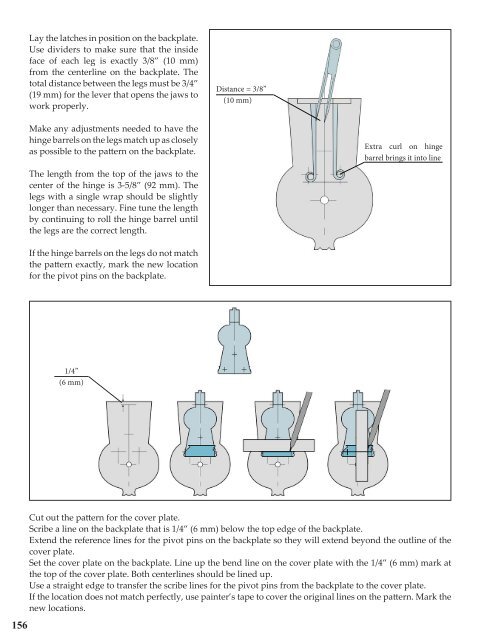The New Spruce Forge Manual of Locksmithing: A Blacksmith’s Guide to Simple Lock Mechanisms
The New Spruce Forge Manual of Locksmithing: a Blacksmith’s Guide to Simple Lock Mechanisms is a totally revised and expanded version of the original work from 1999. This new hardcover edition, at 304 pages and with more than 800 color photos and illustrations, is more than double the size of the original manual. It is divided into two distinct sections: Technical Information - This section is a reference manual in itself that covers the specific tools and techniques needed to build all the parts for each lock, as well as providing the information needed to understand the assembly instructions outlined in the second section. The Locks: Patterns & Instructions - This section provides the plans and detailed instructions for each of the 14 lock projects in this new edition. The clear assembly instructions describe when and how to use the technical information provided in section one. The authors have maintained their original trademark style that relies on well-illustrated step-by-step instructions that guide you through the whole lock-making process. They have also kept their low-tech approach that demonstrates how to go about creating good work using only a handful of simple tools. Making blacksmith locks is an age-old skill the authors of this manual are helping to preserve by passing on their knowledge to this book’s readers. The New Spruce Forge Manual of Locksmithing is also an excellent introduction to benchwork, which is a useful skill for any blacksmith to acquire. This manual will become a valuable, trusted and often referred to sourcebook in your blacksmithing library. Hardcover, 304 pages, more than 800 photos and illustrations.
The New Spruce Forge Manual of Locksmithing: a Blacksmith’s Guide to Simple Lock Mechanisms is a totally revised and expanded version of the original work from 1999. This new hardcover edition, at 304 pages and with more than 800 color photos and illustrations, is more than double the size of the original manual.
It is divided into two distinct sections:
Technical Information - This section is a reference manual in itself that covers the specific tools and techniques needed to build all the parts for each lock, as well as providing the information needed to understand the assembly instructions outlined in the second section.
The Locks: Patterns & Instructions - This section provides the plans and detailed instructions for each of the 14 lock projects in this new edition. The clear assembly instructions describe when and how to use the technical information provided in section one.
The authors have maintained their original trademark style that relies on well-illustrated step-by-step instructions that guide you through the whole lock-making process. They have also kept their low-tech approach that demonstrates how to go about creating good work using only a handful of simple tools.
Making blacksmith locks is an age-old skill the authors of this manual are helping to preserve by passing on their knowledge to this book’s readers. The New Spruce Forge Manual of Locksmithing is also an excellent introduction to benchwork, which is a useful skill for any blacksmith to acquire. This manual will become a valuable, trusted and often referred to sourcebook in your blacksmithing library.
Hardcover, 304 pages, more than 800 photos and illustrations.
Create successful ePaper yourself
Turn your PDF publications into a flip-book with our unique Google optimized e-Paper software.
Lay the latches in position on the backplate.<br />
Use dividers <strong>to</strong> make sure that the inside<br />
face <strong>of</strong> each leg is exactly 3/8” (10 mm)<br />
from the centerline on the backplate. <strong>The</strong><br />
<strong>to</strong>tal distance between the legs must be 3/4”<br />
(19 mm) for the lever that opens the jaws <strong>to</strong><br />
work properly.<br />
Distance = 3/8”<br />
(10 mm)<br />
Make any adjustments needed <strong>to</strong> have the<br />
hinge barrels on the legs match up as closely<br />
as possible <strong>to</strong> the pattern on the backplate.<br />
<strong>The</strong> length from the <strong>to</strong>p <strong>of</strong> the jaws <strong>to</strong> the<br />
center <strong>of</strong> the hinge is 3-5/8” (92 mm). <strong>The</strong><br />
legs with a single wrap should be slightly<br />
longer than necessary. Fine tune the length<br />
by continuing <strong>to</strong> roll the hinge barrel until<br />
the legs are the correct length.<br />
Extra curl on hinge<br />
barrel brings it in<strong>to</strong> line<br />
If the hinge barrels on the legs do not match<br />
the pattern exactly, mark the new location<br />
for the pivot pins on the backplate.<br />
1/4”<br />
(6 mm)<br />
156<br />
Cut out the pattern for the cover plate.<br />
Scribe a line on the backplate that is 1/4” (6 mm) below the <strong>to</strong>p edge <strong>of</strong> the backplate.<br />
Extend the reference lines for the pivot pins on the backplate so they will extend beyond the outline <strong>of</strong> the<br />
cover plate.<br />
Set the cover plate on the backplate. Line up the bend line on the cover plate with the 1/4” (6 mm) mark at<br />
the <strong>to</strong>p <strong>of</strong> the cover plate. Both centerlines should be lined up.<br />
Use a straight edge <strong>to</strong> transfer the scribe lines for the pivot pins from the backplate <strong>to</strong> the cover plate.<br />
If the location does not match perfectly, use painter’s tape <strong>to</strong> cover the original lines on the pattern. Mark the<br />
new locations.










